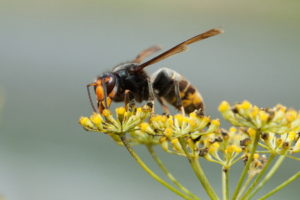Vespa crabro, better known as the European hornet, can be found in every US state east of the Mississippi River including Louisiana, and they are continuing to expand their non-native habitat westward in the country. Just as their name suggests, European hornets are native to Europe, and like all social wasps, this species will readily attack nearby humans and animals in response to seemingly minor external disturbances to their nest. European hornets were first documented in the US back in 1840 when colonies were found in New York state. This makes the European hornet the only true hornet species inhabiting the US, but this may change if the recently introduced Asian giant hornet (V. mandarinia), also known as the “murder hornet,” manages to establish a permanent habitat in the country. It should be mentioned that the well known bald-faced hornet, which can also be found in Louisiana, technically belongs to the yellow jacket groups of wasps, not hornets.
Although European hornets are aggressive, highly venomous, and prevalent in areas where they are found, they are rarely responsible for serious envenomation incidents. This is due to their preference for nesting within tree hollows in wooded rural areas where humans are scarce. Also, unlike many insect pests, European hornets rarely encounter humans because they do not seek out food scraps in and around homes. However, in response to dwindling food sources during the fall and winter seasons, yellow jackets frequently abandon their nests in order to swarm through neighborhoods in search of sweets, meats and fatty foods in garbage bins, at picnics, at cookouts and anywhere they can exploit humans to remain well fed. This scavenging behavior is the sole reason why yellow jackets are the deadliest insects in the US along with honey bees.
While they prefer to dwell in undisturbed habitats, European hornets are known to establish nests in residential areas where they have been found beneath decks, window frames, the underside of eaves, garage rafters, sheds, attics, basements, crawl spaces, and shrubs. Amazingly, a European hornet nest the size of a refrigerator was found in a Louisiana homeowner’s shed. A pest control professional used a gopro camera to record his 45 minute ordeal removing the nest, which can be viewed on Youtube. Although a National Geographic report stated that the nest belonged to European hornets, local news sources said the pests were southern yellow jackets, and in the video itself, the pest control professional could be heard calling the insects “European yellowjackets.” Identifying insect species is a hard business when more than one million have been documented.
Have you ever encountered a wasp nest within your home?





